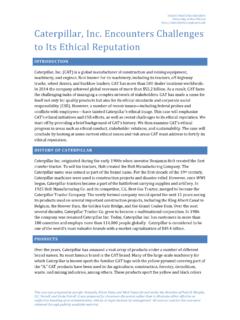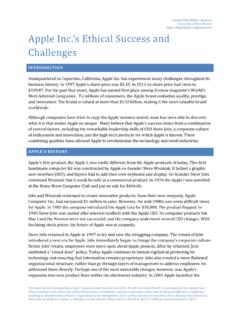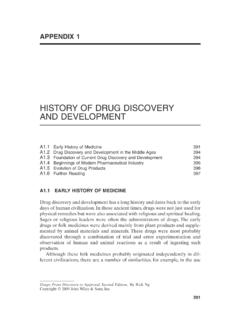Transcription of Patagonia: A Sustainable Outlook on Business
1 Daniels Fund Ethics Initiative University of New Mexico This material was developed by Sarah Suazo, Justin Baca, and Jennifer Sawayda under the direction of Ferrell and Linda Ferrell. It is provided for the Daniels Fund Ethics Initiative at the University of New Mexico and is intended for classroom discussion rather than to illustrate effective or ineffective handling of administrative, ethical, or legal decisions by management. Users of this material are prohibited from claiming this material as their own, emailing it to others, or placing it on the Internet. Please call Ferrell at 505-277-3468 for more information. (2012) patagonia : A Sustainable Outlook on Business INT ROD UC T ION How can businesses make a difference in a world of decreasing resources?
2 patagonia is diligently working toward finding an answer to that question. patagonia is a privately held outdoor clothing company based out of Ventura, California that generates yearly sales of approximately $540 million. patagonia s clothing has been developed and marketed toward a variety of outdoor sports, travel, and everyday wear. The company has integrated core beliefs and values into every product it produces and is known for its innovative designs, exceptional quality, and environmental ingenuity. Its high integrity and commitment to the environment has placed patagonia on the Ethisphere Institute s World s Most Ethical Companies list for six consecutive years since the list was first developed in 2007. This case analysis will start by examining the history of patagonia , including the inspiration behind its current state as an ethical and eco-conscious company.
3 patagonia s core purpose and values are examined, followed by the type of leadership and management styles that have led patagonia to success. Next, we will examine patagonia s many environmental initiatives as well as how these initiatives fit with patagonia s core vision and values. We then describe patagonia s corporate social responsibility, particularly its relationships with its suppliers. We conclude by examining the future of patagonia as it embarks upon new initiatives to advance its vision of environment conservation and restoration. HIST ORY OF PAT AGO NIA Like many successful companies, patagonia stems from one entrepreneur s passion. In 1953 Yvon Chouinard, founder of patagonia , developed a passion for rock climbing. His passions brought him west to the San Fernando Valley in California, where he became an expert at climbing and rappelling.
4 Unfortunately, his passion was limited by a lack of appropriate climbing gear. The only available climbing gear were pitons, metal spikes that were driven into cracks or seams in rocks. These pitons were left in the rock, meaning that a long climb could require hundreds of these tools. Chouinard became inspired after meeting a Swiss climber that had crafted his own set of iron pitons. After turning his parents garage into a coal forge, Chouinard began to make his own reusable pitons that were stronger than what was currently on the market. Word of Chouinard s invention spread, and he began selling his pitons out of the back of his car for $ each. Although the hobby was enough to support him, he often lived on less than a dollar day. Drifting along the 2 California coast, Chouinard took pride in his rebellious lifestyle.
5 However, demand for his gear soon caught up with him. By 1965 Chouinard decided to partner with Tom Frost to create Chouinard Equipment. For nearly a decade Chouinard and Frost made improvements on nearly every climbing tool. In 1972 Chouinard Equipment took its first steps towards environmental consciousness and revolutionized the idea of aluminum chocks to replace the pitons of the climbing industry. These chocks were designed to eliminate damage to rocks as they were wedged by hand rather than hammered into cracks. Chouinard first realized a need for more functional climbing clothing when he purchased a rugby shirt on an overseas trip. The shirt provided protection from the elements and was a colorful contrast to the standard dull colored shirts climbers often wore.
6 Soon Chouinard and his wife Malinda were selling clothing as way to support the hardware Business , but by 1972, the clothing line had expanded to become its own Business venture. The name patagonia was chosen for the clothing line. The name was intended to reflect the mysticism of far off lands and adventurous places located not quite on the map. patagonia took off. Consumers loved patagonia s durable and brightly colored clothing. From the get-go, Chouinard and his wife Malinda knew they wanted to sell items that would have a minimal impact on the environment. In 1985 the firm began donating 1 percent of its total sales to environmental organizations. However, like many companies, patagonia tried to expand too quickly. This wide-scale expansion placed patagonia into dire financial straits.
7 Banks were not willing to provide the company with credit, and patagonia had to lay off one-fifth of its employees. Chouinard considered selling the company. Instead, he chose to go in a more Sustainable direction. The company switched to the more expensive organic cotton in 1996, a risky Business move considering it increased the firm s supply costs. He invested in other Sustainable materials and decided to make products more durable. This was also a risky move because companies often rely on consumers coming back to get replacement products. Conceivably, the more durable the product, the less customers need to purchase from the company. However, the exact opposite occurred: consumers were more willing to do Business with patagonia due to its environmental consciousness and the fact that they could trust patagonia s products to last a long time.
8 Today patagonia is debt-free and is still willing to bend the rules. For instance, the firm which constantly remarks that it places the environment over profits has embarked upon a Buy Less campaign. The campaign encouraged consumers to sell their used patagonia gear on eBay or through patagonia s website. However, some analysts think this will actually increase patagonia sales among those who care about the environment and among those who want to sell their old gear and use the proceeds to purchase new patagonia products. These campaigns and patagonia s environmental consciousness have appeared to pay off: revenue has doubled since 2008. The firm has expanded, albeit more carefully, to 88 global retail outlets and sells its products in other retail establishments such as REI.
9 3 patagonia S PURPOSE AND C ORE VAL U ES When patagonia was first developed, Yvon and Malinda agreed that the company would produce only products of the highest quality and manufactured in the most responsible way. The goal of the company would not be to make money but to share a love for the outdoors and create a diversity of products for all facets of outdoor life. Those values continue to govern the Business practices of patagonia . They selected the following mission statement for the company: Build the best product, cause no unnecessary harm, use Business to inspire and implement solutions to the environmental crisis. patagonia strives to live out its mission statement every day. To make its mission into a reality, patagonia has adopted four core guiding principles for its operations outlined in Table 1.
10 Table 1: patagonia s Four Core Values Quality: Pursuit of ever-greater quality in everything we do. Integrity: Relationships built on integrity and respect. Environmentalism: Serve as a catalyst for personal and corporate action. Not Bound by Convention: Our success and much of the fun lies in developing innovative ways to do things. Source: patagonia , patagonia and Corporate Social Responsibility, November 2007, (accessed November 2, 2012). For patagonia , this means working with friends, hiring self-motivated, intelligent employees, and giving them flexible time to enjoy surfing, climbing, and spending time with their families. Another important value involves finding ways to be responsible by restoring or reusing, which has prompted the company to open retail locations in old buildings that have been restored.










